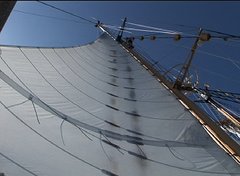Joining the South Pacific expedition in its final leg, I
was surprised at what I found. I knew the students had encountered rough seas
that dragged down the hardiest of them into a woozy world of seasickness.
Broken into three groups, the students had been standing watch, around the
clock in six-hour watches to master nautical science and seamanship skills.
They got their hands wet, conducting science experiments, often in the middle
of the night.
 |
| Diego sheet handling |
Living in their midst for the past week has offered some
clues to good humor and bonds of camaraderie that seemed as tight and secure as
the knots that hold fast the ship's sails.
Friendship began to form in the first five weeks of intensive coursework
- 9 a.m. to 5 p.m. at Hopkins Marine Station in Pacific Grove. They all piled
in like puppies, living and eating together in group housing.
Then they moved to the Brigantine sailing vessel, where
personal space gives way to collective life in narrow confines. The 138-foot ship offers few places to hide
for the company of 38 people aboard. A
student can retreat to a bunk; however these nests are hot and stuffy-usually
avoided except for sleeping.
Much of their time is spent elbow-to-elbow with many
hands on a line hauling and easing sails on slippery, pitching decks, or
standing watch for hazards that might lurk ahead. Each took turns wrestling the
giant wheel at the helm to keep the sluggish ship on course, through squalls
and under night skies with dazzling stars. On top of that, as budding
scientists, each spent hours in the wet and dry labs, analyzing samples
collected from the deep or found on coral reefs. Twice a day, while underway, they lowered
various forms of nets or oceanographic instruments to gather raw material of
scientific inquiry.
When they get a chance to venture to the decks below --
and not catching catnaps -- students clean heads, handrails, floors. They
navigate ladders - the ship's name for steep stairs - and narrow halls. When
the wind blows enough to set sail, the boat heels by 12 degrees or more.
Students lurch like tippy bowling pins, bumping into walls and each other, and
then awkwardly thrown by the force of a wave that strikes the ship like an
unseen bowling ball. Crash. Thunk.
Splat. Laughter. "You Ok?" asks a concerned teaching assistant,
looking at the student sprawled on his back. A direct response doesn't come,
just uncontrollable, breath-catching laughter. It's infectious as everyone
within earshot begins to laugh.
Even dining in the salon is a delicate dance that can
easily slide into calamity. A no-elbows-on-the-table rule is more than just
etiquette. As the boat rocks and rolls, the gimbaled tables swing with hidden
counterweights to keep them level to the horizon. An errant elbow on the table
can send dishes of steaming food crashing to the floor or colleagues laps.
Regular updates on a white board record the time between major spills, the last
time food had skittered across the floor.
It would be easy for the hive-mind of this collective to
turn sour, judgmental or irritable. Instead, it developed a lightness of being,
with songs, strumming of ukuleles, and sweet, self-deprecating humor. The
ripple of laughter usually begins with whomever made the embarrassing misstep.
Others joined in, laughing with the light-hearted
perpetrators, not at them.
 |
| Lindsay taking the plunge - proper use of the head rig |
On the first day of classes, Block warned them that this
class was like none other. Sailing 2,600 nautical miles (2992 miles) across the
open ocean with rough seas and forceful winds has its dangers, she said. The
students would literally hold their colleagues' lives in their hands. And so
they looked after each other, including offering water or soda crackers one
particular rough stretch to the half-dozen miserable souls curled up on deck
beside the rail between bouts of nausea.
The five weeks also brought revelry: "Swizzle"
nights of song and skits, a tradition that dates back when rum once was allowed
on board and into the fizzy Swizzle punch. They celebrated birthdays. Two of
them celebrated for two days in a row, as the ship crossed the date line
between Tonga and American Samoa. Eleven lopped off their hair with shipboard
clippers - as many women as men - mostly
with buzz cuts and one Mohawk. They scrubbed decks together. They danced and
sang the night away on shore leave at the Reload, which calls itself,
"Probably the best bar in Tonga." As the days passed and blurred
together, the ship became home, their fellow sailors surrogate family members. "We've never had a bad Stanford @
Sea," said Dunbar, the Stanford professor who shared the role of the
expedition's chief scientist. "But this is the happiest. I cannot sleep
sometimes because of all of the giggling."
-- Ken Weiss


Thank you for your observations. What an adventure it has been for all.
ReplyDeleteLove the picture and your account is duch a good summary! Thank you very much.
ReplyDelete